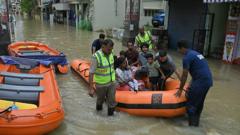Armenia is working diligently to transform into a leading technology center in the Caucasus through innovative education programs, leveraging its rich history in mathematics, and welcoming skilled professionals to bolster its tech ecosystem.
Armenia's Ambitious Quest to Become the Technology Hub of the Caucasus

Armenia's Ambitious Quest to Become the Technology Hub of the Caucasus
Exploring Armenia's efforts to establish itself as a tech power, focusing on youth education, diaspora connections, and the influx of IT talent from Russia.
Armenia is on a mission to cultivate a flourishing tech environment reminiscent of Silicon Valley, specifically tailored for the Caucasus region. In the heart of Yerevan, nine-year-old Slavik demonstrates his ingenuity with a simple LED-laden invention, illustrating how tech education starts young. Under the guidance of young tech coach Maria, children like Slavik, 14-year-olds Eric and Narek, and eleven-year-old Arakel, proudly present their innovative projects, including smart greenhouses and automated devices that simplify daily chores.
The initiative driving this technological enthusiasm is the Armath program, which translates to "root" in English. Launched in 2014 by the Union of Advanced Technology Enterprises (UATE), this educational effort now boasts 650 labs across the nation, focusing on inspiring students in coding, robotics, and engineering. UATE's CEO, Sarkis Karapetyan, highlights the program as a success of a public-private partnership, enhanced by an annual government budget of $2 million dedicated to staffing these education labs.
Despite geographic and resource challenges, Armenia draws on its historical strengths in mathematics and computing. The nation is capitalizing on a solid tech legacy that spans back to the Soviet era, showcasing success stories like Picsart, an AI-based photo-editing company, now valued at $1.5 billion. Reports indicate that Armenia holds an advantageous position for launching businesses compared to its neighbors, with a global ranking of 57, surpassing Georgia and Azerbaijan.
The expansive Armenian diaspora plays a pivotal role in the tech landscape, with around 75% of the global Armenian population residing outside Armenia and maintaining vital connections to the U.S. tech sector. Figures like Samvel Khachikyan, the director at SmartGate venture capital, exemplify the support offered to Armenian start-ups looking to penetrate the U.S. market.
Recent geopolitical events have further reshaped Armenia's tech narrative, particularly following Russia's invasion of Ukraine. Thousands of Russian IT experts have sought refuge in Armenia, significantly enhancing local expertise amidst evolving tech needs. Industry reconnections and movement from established firms like Nvidia underscore a dynamic shift, filling skill deficiencies in sectors from cybersecurity to data processing.
While migration poses potential economic pressures, the general outlook remains positive. Experts predict significant growth in the Armenian tech industry, fueled by successful ventures and a vibrant start-up culture, as observed by the burgeoning success story of Service Titan after its stock market ascent. The blend of educational initiatives and robust community support hints at a bright future for Armenia's ambitions as it seeks to solidify its status as a technology powerhouse in the Caucasus.
The initiative driving this technological enthusiasm is the Armath program, which translates to "root" in English. Launched in 2014 by the Union of Advanced Technology Enterprises (UATE), this educational effort now boasts 650 labs across the nation, focusing on inspiring students in coding, robotics, and engineering. UATE's CEO, Sarkis Karapetyan, highlights the program as a success of a public-private partnership, enhanced by an annual government budget of $2 million dedicated to staffing these education labs.
Despite geographic and resource challenges, Armenia draws on its historical strengths in mathematics and computing. The nation is capitalizing on a solid tech legacy that spans back to the Soviet era, showcasing success stories like Picsart, an AI-based photo-editing company, now valued at $1.5 billion. Reports indicate that Armenia holds an advantageous position for launching businesses compared to its neighbors, with a global ranking of 57, surpassing Georgia and Azerbaijan.
The expansive Armenian diaspora plays a pivotal role in the tech landscape, with around 75% of the global Armenian population residing outside Armenia and maintaining vital connections to the U.S. tech sector. Figures like Samvel Khachikyan, the director at SmartGate venture capital, exemplify the support offered to Armenian start-ups looking to penetrate the U.S. market.
Recent geopolitical events have further reshaped Armenia's tech narrative, particularly following Russia's invasion of Ukraine. Thousands of Russian IT experts have sought refuge in Armenia, significantly enhancing local expertise amidst evolving tech needs. Industry reconnections and movement from established firms like Nvidia underscore a dynamic shift, filling skill deficiencies in sectors from cybersecurity to data processing.
While migration poses potential economic pressures, the general outlook remains positive. Experts predict significant growth in the Armenian tech industry, fueled by successful ventures and a vibrant start-up culture, as observed by the burgeoning success story of Service Titan after its stock market ascent. The blend of educational initiatives and robust community support hints at a bright future for Armenia's ambitions as it seeks to solidify its status as a technology powerhouse in the Caucasus.


















